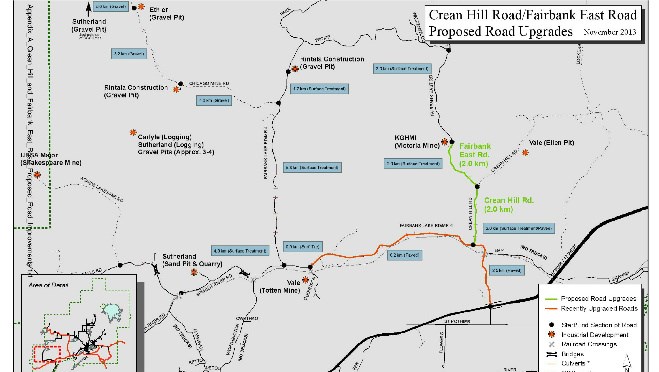If all goes according to plan, in five years, Greater Sudbury should have a new mine employing 150-300 people.
City council approved a plan this week to cost-share $5 million in roads improvements with KGHM International, the company that's building the mine in Worthington.
In exchange for paying 75 per cent of the cost of improving the four-kilometre road, KGHMI wanted the city to remove road restrictions on Fairbanks and Crean roads so they can haul construction materials in, and, in about five years, ore from the Victoria mine out to be processed.
Mark Frayne, KGHM's manager of technical services, told councillors Tuesday the company aims to begin full construction in June, a process that would employ about 350 people.
“Once we go into initial stages of production, it will … be about 150 people,” Frayne said. “And if we go into full expansion, if everything is what we think it is, it will go to around 300 people.”
The Victoria Advanced Exploration Project, as it's know, is on land first mined in the 1890s, then closed in the 1920s. The former Inco reopened the mine in the 1970s, and made a deal with KGHM's predecessor, FNX, in 2002, to take control. A long and thin orebody – about 50 kilometres long – was discovered in 2010, which the company now wants to bring into production.
Estimates include 700 million pounds of copper, 700 million pounds Nickel and 3.5 million ounces of precious metals.
It's developing the site under an arrangement with Vale, in which KGHM will build and operate Victoria as the sole owner of the project, with Vale receiving a royalty, as well as agreeing to buy the ore extracted from the mine.
“It's what we call a needle deposit.”
Frayne told councillors the company should have all permits in place by the end of 2013, including from the Ministry of the Environment.
Road improvements will see more gravel added to bolster the strength of the roads, improved drainage, paving the surface and shoulders, and curves will be straightened in some areas.
In exchange for paying the majority of the costs to upgrade the roads, KGHM wanted the city to agree to not impose load restrictions, and not charge the company for routine road maintenance.
While welcoming the added jobs, Ward 1 Coun. Joe Cimino wondered why the provincial or federal government weren't asked to contribute to the road improvements, since they earn more money in corporate taxes from mining than the city does from property taxes.
“Is this a site where the city is going to receive more money in terms of property taxes?”
Frayne said KGHM pays property taxes on its other mine sites in the city, “and I expect this one will be no different.”
But Ward 3 Coun. Claude Berthiaume said staff should at least approach other levels of government for support.
“There's billions of dollars in mining royalties going to the provincial government,” Berthiaume said. “They'll be benefiting from this, a lot more than, I believe, the municipality will.”
So part of the motion councillors approved included language directing staff to see if there are ways to access funding for the road from the province and the feds.
Join Sudbury.com+
- Messages
- Post a Listing
- Your Listings
- Your Profile
- Your Subscriptions
- Your Likes
- Your Business
- Support Local News
- Payment History
Sudbury.com+ members
Already a +member?
Not a +member?
Sign up for a Sudbury.com+ account for instant access to upcoming contests, local offers, auctions and so much more.
